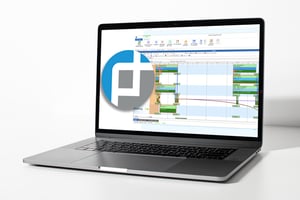Mastering Forecast Accuracy for Enhanced Scheduling Efficiency
Every aspect of the process, from procurement to production, must be finely tuned to ensure timely delivery and optimal resource utilization in packaging manufacturing. However, one of the biggest challenges faced by purchasing managers in this industry is forecasting accuracy. Inaccurate forecasts can lead to overstocking, underutilization of resources, and missed delivery deadlines, all of which can have a significant impact on the bottom line.
In this blog, we'll look into the intricacies of forecast accuracy improvement techniques in scheduling, focusing on how integration between advanced planning and scheduling (APS) systems like PlanetTogether and ERP, SCM, and MES systems can revolutionize the packaging manufacturing process.

The Importance of Forecast Accuracy
Let's first understand why it's so crucial in packaging manufacturing. Accurate forecasts serve as the foundation for effective scheduling, procurement, and production planning. By predicting future demand with precision, companies can optimize inventory levels, reduce lead times, and allocate resources efficiently.
However, achieving high forecast accuracy is easier said than done, especially in industries where demand fluctuations are common. Factors such as seasonality, market trends, and unforeseen events can all impact demand, making it challenging to predict accurately. That's where advanced planning and scheduling systems come into play.

Integration between PlanetTogether and ERP, SCM, and MES Systems
PlanetTogether is a leading APS solution that offers powerful tools for optimizing production schedules based on demand forecasts, resource availability, and other constraints. When integrated with ERP, SCM, and MES systems such as SAP, Oracle, Microsoft Dynamics, Kinaxis, and Aveva, it creates a seamless ecosystem that streamlines the entire manufacturing process.
By connecting these systems, purchasing managers gain access to real-time data and insights that enable them to make informed decisions regarding procurement, production planning, and scheduling. For example, integration with ERP systems allows for automatic updates of inventory levels and order statuses, ensuring that scheduling decisions are based on the most up-to-date information available.

Forecast Accuracy Improvement Techniques
Now let's explore some techniques for improving forecast accuracy in scheduling:
Data-driven Forecasting: Leverage historical sales data, market trends, and customer insights to develop more accurate demand forecasts. Advanced analytics tools can help identify patterns and anomalies in the data, enabling purchasing managers to make more informed predictions.
Collaborative Planning: Foster collaboration between different departments, including sales, marketing, and production, to gather input and insights for forecasting. By involving key stakeholders in the process, companies can ensure that forecasts are based on a comprehensive understanding of market dynamics and internal capabilities.
Demand Sensing: Implement demand sensing techniques such as point-of-sale data analysis and social media monitoring to capture real-time demand signals. By continuously monitoring market trends and consumer behavior, companies can adjust their forecasts dynamically to reflect changing conditions.
Scenario Planning: Develop multiple forecast scenarios based on different assumptions and scenarios, such as best-case, worst-case, and most likely outcomes. This allows companies to assess the potential impact of various factors on demand and prepare accordingly.
Machine Learning and AI: Harness the power of machine learning and artificial intelligence algorithms to improve forecast accuracy over time. These technologies can analyze large volumes of data and identify patterns that human analysts may overlook, resulting in more precise predictions.
Continuous Improvement: Treat forecast accuracy as an ongoing process rather than a one-time task. Regularly review and refine forecasting models based on feedback and performance metrics to ensure continuous improvement over time.
Forecast accuracy plays a critical role in scheduling efficiency and overall operational performance in packaging manufacturing. By implementing advanced planning and scheduling solutions like PlanetTogether and integrating them with ERP, SCM, and MES systems, purchasing managers can unlock new levels of efficiency and responsiveness in their operations.
By adopting data-driven forecasting techniques, fostering collaboration across departments, leveraging demand sensing technologies, and embracing machine learning and AI, companies can enhance their forecast accuracy and stay ahead of the competition in today's fast-paced market environment.
Remember, achieving forecast accuracy is not a one-size-fits-all solution. It requires a combination of advanced tools, strategic insights, and continuous improvement efforts. By embracing these principles and leveraging the latest technologies, packaging manufacturers can optimize their scheduling processes and drive sustainable growth in the years to come.
Are you ready to take your manufacturing operations to the next level? Contact us today to learn more about how PlanetTogether can help you achieve your goals and drive success in your industry.


